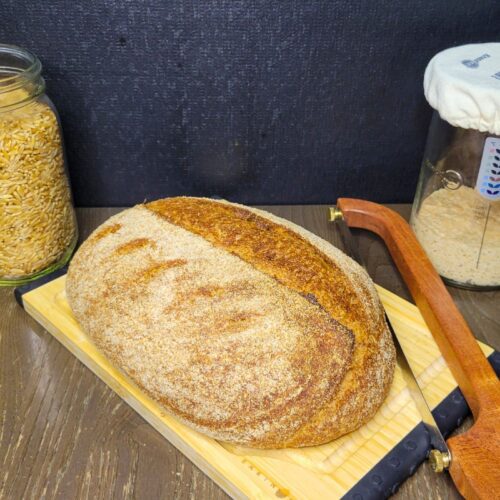
100% Fresh Milled Flour Sourdough Bread
This fresh milled flour sourdough bread recipe is made with 100% freshly ground wheat, so let me share this easy method with you. This FMF Sourdough bread is made all in one day, and I simplify my original recipe, so this method is great for beginners! Also, to help I have a tutorial video where we can make this together.
Equipment
- 1 High Heat Oven safe vessel with lid like a Dutch Oven
Ingredients
- 500 -550 g Fresh Milled Flour I recommend hard white or hard red when starting out. *See notes for more wheat varieties
- 450 g Room Temperature Water
- 12 g Sea Salt (2 tsp) You can use between 10-15g of salt
- 115 g Bubbly Sourdough Starter (1/2 cup) Fed between 8-12 hours ago
- *Optional- 20g Vital Wheat Gluten (2 TBSP) This is not required, but will make a nicer loaf.
Instructions
- Firstly, make sure your sourdough starter was fed within 8-12 hours, and is nice an bubbly. I like to use it when the starter is just starting to drop.

- Then, mill your flour.
- In a large mixing bowl, measure out room temperature (non-chlorinated) water.
- Add the sourdough starter to the water. It may float, but if not see my post above about the float test.

- Mix the sourdough starter into the water.
- Then, add the freshly milled flour to the water mixture.
- Add the salt, and if using the vital wheat gluten add that as well.
- Mix all ingredients to combine, making sure there is no dry flour left. This mixture will be lumpy, and shaggy. See video for texture. Cover, and let this sit for about 30 minutes.
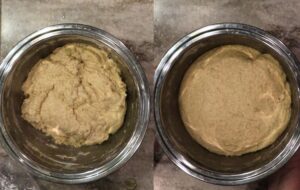
- After 30 minutes, remove cover, then stretch and fold the dough a few times as you turn the bowl a bit with each turn. Cover, and let sit for another 30-60 minutes. Then, do another series of stretch and folds. Be gentle as you go, each time it should feel stretchier and softer. Do these stretch and folds every 30-60 minutes until the dough has risen about 20-30%. It should be stretchy, smooth, and there will be some air bubbles in the dough. This step generally takes only about 3-5 hours. (See the post above about the time/temp variations, and tips)
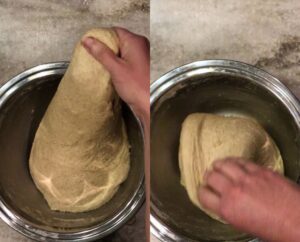
- After the dough has risen a bit, it is ready to shape in your banneton. Lightly spritz your banneton liner cloth with a tiny bit of water, and sprinkle flour into the banneton liner all around. (If making this for someone who is gluten sensitive, make sure to use rice flour for this.)
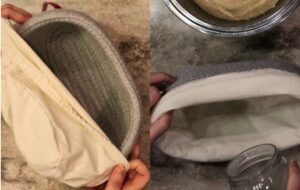
- Place your sourdough dough on your work surface, and gently stretch it into a loose rectangle, trying not to press the air bubbles out of the dough.
- Then, fold one of the long sides of the dough into the center, and then the other side into the middle meeting edge to edge.
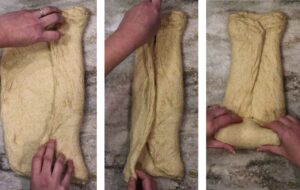
- Gently roll the dough up. (see video for shaping visual)
- Place your dough seam side up into the prepared banneton. Pinch the seam together, making sure there is some surface tension on the face of the dough.
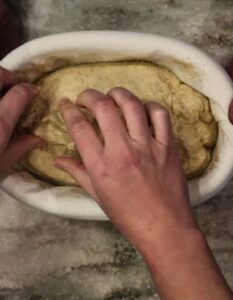
- Cover, and place the banneton in the fridge for 1-3 hours. I DO NOT RECOMMEND AN OVERNIGHT FERMENT! An overnight ferment will over-ferment your dough. If you are in a hurry, you can bake it at this step before placing it in the fridge. If you want your bread to be more sour, then leave it in the fridge for 3 hours, I don't recommend any longer than that.
- Preheat your oven to 480*F. (If using a Dutch oven, preheat it with the lid on during this preheat.) In the video I use a stainless steel baking dish with a lid, and I don't preheat that pan.
- Place a piece of parchment paper on the counter, and then flip the dough out of the banneton onto the parchment paper.
- Score the dough how you wish.
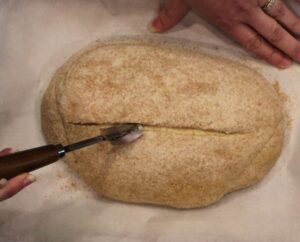
- Place the parchment paper into your baking vessel, and bake covered for 35 minutes. Then, lower the oven temperature to 450*F and finish baking with the lid off for 20-25 minutes. I like to check the center of the loaf's temperature to be 210*F.
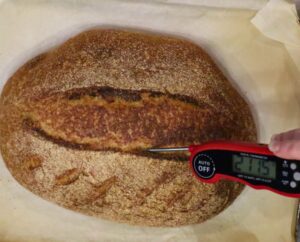
- Let the loaf cool completely before slicing.

- Lastly, enjoy!

Video
Notes
Wheat Varieties- I recommend all hard wheat (white, red, or combo of both) in the beginning. Also, if not choosing to use Vital Wheat Gluten, you will need a hard wheat. If you want to make a loaf with an Ancient Grain (Spelt, Einkorn, Kamut), you can do this with the use of the vital wheat gluten.
How To Store This Bread:
To store this 100% fresh milled flour sourdough bread, I like to keep it at room temperature for up to 3 days. You can wrap the loaf in a cotton or linen bread bag, a clean kitchen towel, or place it in a paper bag. This allows the bread to breathe, preventing it from becoming soggy while maintaining the crust's crispness.
If you prefer a soft crust, you can store in a plastic or airtight bag/container, as this will hold the moisture in, but also cause it to mold a bit faster.
For long term storage, I like to let the loaf cool completely, and then slice it. Place it in a freezer bag or container. It will last in the freezer for up to 4 months.